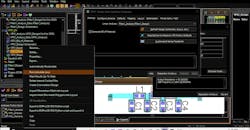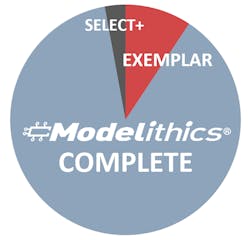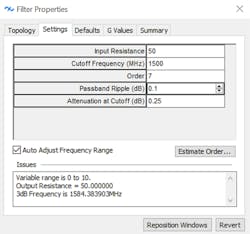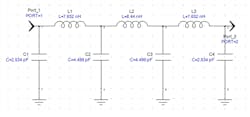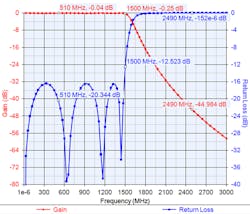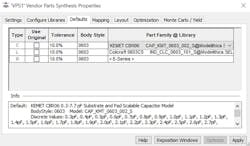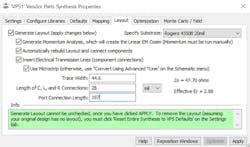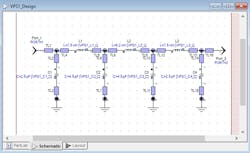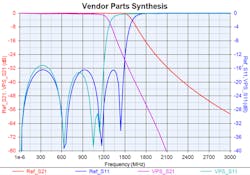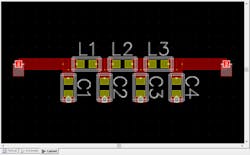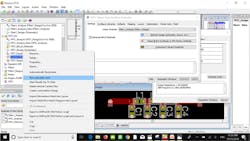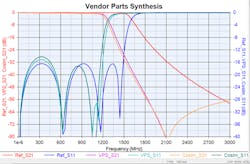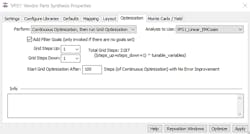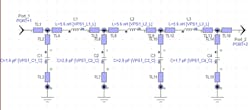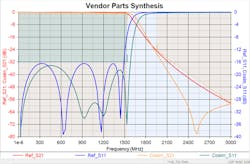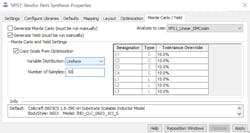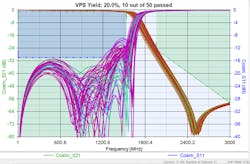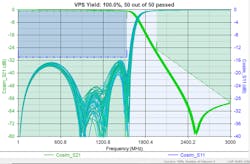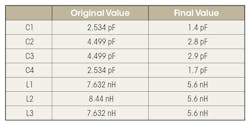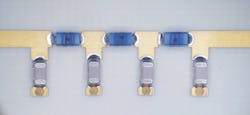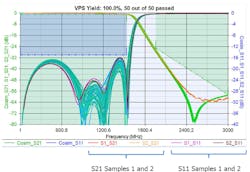Take the Guesswork out of Discrete Circuit Design
Download this article in PDF format.
Designing circuits with discrete resistors, inductors, and capacitors can be a tricky problem for RF design engineers for several reasons. For example, consider the scenario in which a filter must be designed with discrete inductors and capacitors. In these situations, simple software tools are available that can automatically calculate the inductor and capacitor values. The software generates these values based on user-specified parameters, resulting in a filter design with an optimal frequency response.
However, these types of software tools also come with limitations. For one, they only calculate ideal inductor and capacitor values. Since real-world discrete inductors and capacitors are not ideal components, their actual performance does not entirely match the theoretical performance of ideal parts.
Specifically, real-world discrete inductors and capacitors contain parasitics that affect their performance. That means that the performance of a real filter designed with these components can differ significantly from the calculated performance of a theoretical filter designed with ideal parts of the same value.
The presence of parasitics is not the only factor that must be taken into account. With a software tool, a seemingly infinite amount of component values can be calculated to satisfy any given criteria. However, designers must keep in mind that vendors only manufacture inductors and capacitors with a finite number of values. Thus, it may not even be possible to obtain inductors and capacitors with the exact values generated by a software program. While one could simply find real parts with the closest values, this factor can nonetheless have an impact.
Another key consideration involves the physical effects of metal traces that connect the components together. This metallization impacts the overall filter performance, creating an additional challenge for designers.
When looking at all of these factors as a whole, it quickly becomes apparent that designing filters or other RF circuits (i.e., amplifiers, matching networks, diplexers, oscillators, etc.) with discrete inductors and capacitors is anything but a straightforward process. Oftentimes, obtaining desired results comes at the expense of a long and difficult trial-and-error process in the lab. Those who have experienced this can likely attest that it’s a tedious operation.
To overcome these challenges, Keysight Technologies added a feature to its Genesys software that can help designers save time and effort when designing and building circuits with discrete resistors, inductors, and capacitors. This feature, called Vendor Parts Synthesis (VPS), enables users to quickly design circuits using models of real vendor components. With VPS, both component parasitics and the finite number of real component values can be accounted for, provided that suitably accurate and scalable parasitic models for the components are available.
In addition, VPS incorporates electromagnetic (EM)/circuit co-simulation to ensure accuracy. It also includes a yield analysis, which allows designers to determine the component tolerances needed to meet production requirements. This feature relies on integration of VPS with scalable parasitic models that enable statistical simulations.
VPS-enabled design flows are made possible by Modelithics Microwave Global Models, which are included in the Modelithics COMPLETE Library. These part-value scalable models accurately capture substrate-dependent parasitic behavior. They allow for optimization of part values as well as statistical simulations. The Modelithics SELECT+ Library, a subset of the COMPLETE Library (Fig. 1), is now part of the Genesys software and contains the vendor part models used in the example presented in this article.
1. The Modelithics SELECT+ and EXEMPLAR Libraries are both subsets of the Modelithics COMPLETE Library.
To demonstrate the VPS feature, this article focuses on a design example of a lowpass filter with a passband to 1.5 GHz. It details the design process and reveals the simulated results. Also presented is the measured data of two filters that were built, enabling a comparison between simulation and measurement results.
Starting the Design Process
2. The filter is specified as a 7th-order lowpass filter with a cutoff frequency of 1,500 MHz.
Users can begin the design process by selecting Syntheses>Passive Filter from the Genesys workspace tree. Figure 2 shows the resulting user interface. Clicking the Topology tab allows users to specify the type and shape of the filter along with the subtype. For this design, the type and shape are specified as Lowpass and Chebyshev, respectively. The subtype is set to Minimum Inductor.
3. Shown is the filter schematic with ideal component values.
As seen in Fig. 2, clicking the Settings tab allows users to specify the parameters. This design is a 7th-order lowpass filter with a cutoff frequency of 1,500 MHz. The passband ripple is specified to be 0.1 dB, while the attenuation at the cutoff frequency is specified at 0.25 dB. Figure 3 shows the generated schematic based on the parameters entered. The results of the circuit simulation are given in Figure 4, including insertion loss and return loss plots.
4. This is the simulated frequency response of the generated filter with ideal components.
While these results clearly look acceptable, one must realize that the filter simply consists of ideal components rather than real-world parts. A closer inspection of the schematic reveals component values that are not standard manufacturer part values. On top of that, the simulation obviously does not account for the real-world physical effects of metal interconnections. Hence, the design process is still not complete at this point.
VPS to the Rescue
It’s at this stage in the process where VPS steps in. To start VPS, users can select Syntheses>Vendor Parts Synthesis from the workspace tree. Doing so will result in the Vendor Parts Synthesis Properties user interface (Fig. 5). Clicking the Configure Libraries tab reveals the part libraries that are available for the design. The aforementioned Modelithics SELECT+ Library is selected here by default.
5. Designers can select the part families they wish to use in the "Vendor Parts Synthesis Properties" user interface.
As shown in Fig. 5, selecting the Defaults tab lets users choose the part families they wish to use for the design. For this filter, the Kemet CBR06 capacitor part family and Coilcraft 0603CS inductor part family are selected. Users can also specify the component tolerances. For now, both part families are set to a tolerance of 10%, which is the default value. However, this will be examined in more detail later when a yield analysis is performed.
Clicking Apply will prompt users to select a substrate. For this filter, the chosen substrate is 20-mil-thick Rogers RO4350B from the Modelithics SUBSTRATE Library, which is a collection of measurement-based substrate definitions.1
6. Layouts can be automatically generated. Users can specify "Trace Width"; "Length of C, L, and R Connections"; and "Port Connection Length."
The next step is to generate a layout by clicking the Layout tab in the Vendor Parts Synthesis Properties user interface (Fig. 6). Note that the Generate Momentum Analysis checkbox must be checked so that an EM/circuit co-simulation can be performed later. Users can also specify the Trace Width, which is set here to 44.6 mils. Length of C, L, and R Connections and Port Connection Length are two additional parameters that users can specify. For this design, these parameters are set to 28 and 197 mils, respectively. Clicking Apply generates a new VPS schematic (Fig. 7).
7. The VPS schematic includes components from the Kemet and Coilcraft part families along with microstrip interconnections and junction discontinuities.
The VPS schematic includes components from the selected part families with values that are as close as possible to the component values in the original, or reference, schematic. This new schematic also includes microstrip interconnections and junction discontinuities. Figure 8 shows the results obtained from the simulation of the new VPS circuit along with the results of the original circuit simulation. The frequency response of the new VPS circuit is shifted downward by about 300 MHz in comparison to the original circuit’s frequency response.
8. The simulated frequency response of the new VPS circuit is shifted downward in comparison to the simulated frequency response of the original circuit.
A circuit simulation only represents part of the task at hand. To ensure accuracy, an EM/circuit co-simulation must be performed. First, the actual layout can be viewed by clicking the Layout tab (Fig. 9). By right-clicking VPS1_Momentum in the workspace tree and selecting Run (calculate now), users can perform an EM/circuit co-simulation (Fig. 10).
9. This is the layout of the lowpass filter.
10. An EM/circuit co-simulation can be executed by right-clicking "VPS1_Momentum" in the workspace tree and selecting "Run (calculate now)."
Figure 11 shows the results of the EM/circuit co-simulation along with the results of the previous VPS and reference circuit simulations. One can see that the EM/circuit co-simulation deviates even further from the desired performance.
11. The EM/circuit co-simulation results stray even further from the desired performance.
Optimizing the Filter and Performing a Yield Analysis
Since the simulation results clearly show that the filter does not meet the required performance, the next step is to optimize the design. Users can begin the optimization process by clicking the Optimization tab in the Vendor Parts Synthesis Properties user interface (Fig. 12).
12. The optimization process involves two steps: "Continuous Optimization" followed by "Grid Optimization."
As seen in Fig. 12, the optimization process first involves what’s known as a Continuous Optimization. That step is followed by a Grid Optimization, which is a grid search of the nearest component values. By default, the Grid Steps Up and Grid Steps Down parameters are each set to one, meaning the software will search one step up and one step down in value. For this example, these default settings are left intact, resulting in 2,187 total grid steps.
Clicking Apply subsequently prompts users to specify the optimization goals. For this filter, the optimization goal is set to 1 dB for the passband transmission and 16 dB for the passband reflection. For the stopband transmission, the optimization goal is set to 25 dB. VPS automatically identifies the stopband frequency range, which in this case starts at a frequency of 1,956.31 MHz.
13. Following optimization, a new VPS schematic is generated with updated component values.
Performing the optimization leads to a new VPS schematic with optimized component values (Fig. 13). Figure 14 shows the EM/circuit co-simulation results of the optimized filter along with the results of the reference circuit simulation. They demonstrate that the filter now achieves the desired performance.
14. The new EM/circuit co-simulation results reveal a frequency response that meets the desired performance.
A yield analysis is the next and last step. It allows designers to determine if the component tolerances are sufficient for production requirements. To perform a yield analysis, users must click the Monte Carlo / Yield tab in the Vendor Parts Synthesis Properties user interface (Fig. 15). All components are listed, each with a tolerance of 10% as specified earlier. After first clicking Apply in the interface shown in Fig. 15, users can run the yield analysis by right-clicking VPS1_Yield in the workspace tree and selecting Run (calculate now).
15. Shown is the user interface for performing a yield analysis. All components and their tolerances are listed.
The results of the yield analysis are depicted in Figure 16, revealing that a 10% tolerance for all components only produces a 20% yield. To increase the yield, the three inductors were each set to a tolerance of 2%; C1 and C4 were each set to a tolerance of ±0.05; and C2 and C3 were each set to a tolerance of ±0.1. Modifying the component tolerances is achieved via the previously shown user interface (Fig. 15, again).
16. The yield is only 20% when all components have a 10% tolerance.
Figure 17 reveals the outcome of the new yield analysis: the new component tolerances result in a 100% yield. As a side note, while the tolerances of C2 and C3 could each have been set to ±0.05, it was determined that a tolerance of ±0.1 for each still produced a 100% yield. The design process is complete at this stage. VPS also conveniently generates a bill of materials (BOM) for the design.
17. A 100% yield is achieved after specifying different component tolerances.
The table compares the final component values with the component values of the original schematic. There’s quite a noticeable difference between the final and original values, thereby illustrating the difficulty of manually trying to determine the correct component values.
Shown is a comparison of the original and final component values.
Measurement Results and Closing
18. This is one of the filters that was built. The actual Kemet capacitors and Coilcraft inductors are shown here.
To validate the simulated results presented, two filters were built and measured (Fig. 18). The filters were built with the same Kemet capacitors and Coilcraft inductors included in the simulations. Figure 19 shows the measured data of both filters along with the simulated results of the yield analysis. The measured data agrees with the simulated results, as both the measured insertion loss and return loss closely match the simulated results. Hence, the measured data validates the effectiveness of VPS.
19. Both filters were measured to demonstrate that the measured data corresponded to the simulated results.
In closing, VPS is an effective tool that can rescue designers from the headaches that come with manually trying to determine correct resistor, inductor, and capacitor values when building any RF circuit in the lab. Since VPS allows designers to easily design circuits with scalable actual vendor part models from Modelithics, it effectively eliminates the process of finding the right components by guesswork. The result is a much quicker, much cheaper, and much less painful process.
Acknowledgements
I would like to thank How-Siang Yap from Keysight Technologies for his support. I would also like to thank Laura Levesque and everyone at Modelithics for their support and for building and testing the filter presented in this article.
Reference:
1. The Modelithics Substrate Library can be requested as a free update by contacting Modelithics at [email protected]. Please mention this article with the request.
